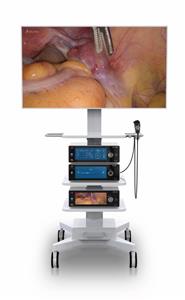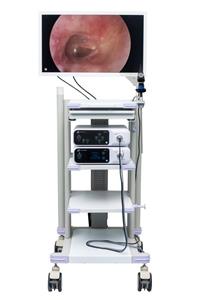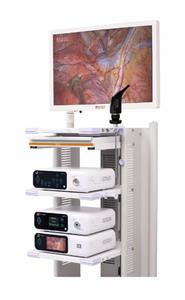Functional Endoscopic Sinus Surgery 1
Ankit Patel, MD
Introduction to Functional Endoscopic Sinus Surgery
Rhinology and sinus surgery have undergone a tremendous expansion since the discourses of Messerklinger and Wigand in the late 1970s. Imaging advances, increased understanding of the anatomy and the pathophysiology of chronic sinusitis, and image-guided surgery have allowed surgeons to perform more complex procedures with increased safety.
Outstanding short- and long-term results have been reported in the literature. Senior et al reported that symptoms improved in 66 of 72 (91.6%) patients following endoscopic sinus surgery, with a mean follow-up time of 7.8 years. In addition, endoscopic sinus surgery significantly influences quality of life; Damm et al reported an improvement in quality of life for 85% of their patient population, with a mean follow-up time of 31.7 months.
Although functional endoscopic sinus surgery is the primary approach used today for the surgical treatment of chronic sinusitis, the time-honored external approaches still play a role. Therefore, familiarity with endoscopic and external approaches, in conjunction with a precise understanding of the anatomy, ensures optimal patient care and outcome.
A recently developed alternative to functional endoscopic sinus surgery is Balloon sinuplasty.This technique uses balloon catheters to dilate the maxillary, frontal, and sphenoid natural ostia without bone or soft-tissue removal. Reports show persistent patient symptom improvement and sinus ostia patency. Further study and long-term outcomes with this technology will determine its role in endoscopic sinus surgery.
Indications for Endoscopic Sinus Surgery
Endoscopic sinus surgery is most commonly performed for inflammatory and infectious sinus disease. The most common indications for endoscopic sinus surgery are as follows:
· Chronic sinusitis refractory to medical treatment
· Recurrent sinusitis
· Nasal polyposis
· Antrochoanal polyps
· Sinus mucoceles
· Excision of selected tumors
· Cerebrospinal fluid (CSF) leak closure
· Orbital decompression (eg, Graves ophthalmopathy)
· Optic nerve decompression
· Dacryocystorhinostomy (DCR)
· Choanal atresia repair
· Foreign body removal
· Epistaxis control
Typically, endoscopic sinus surgery is reserved for patients with documented rhinosinusitis, based on a thorough history and a complete physical examination, including CT scans if appropriate, and in whom appropriate medical treatment has failed.
Medical therapy alone may be inadequate for treatment of nasal polyposis. Aukema et al found that although 12 weeks of treatment with fluticasone propionate nasal drops reduced the need for sinus surgery in patients with nasal polyposis and chronic rhinosinusitis, 14 of 27 patients still required surgery. Similarly, antrochoanal polyps require surgical removal.
Nasal masses
Increasingly, selected nasal masses and tumors are being removed endoscopically. Endoscopic removal of inverted papilloma is controversial. Endoscopic surgery can be performed for limited lesions in which definitive control and margins can be obtained endoscopically; this circumstance can be predicted preoperatively via nasal endoscopy and imaging.
More extensive lesions should be approached externally; either a lateral rhinotomy method or a midfacial degloving method can be used for en bloc tumor removal. Further research with long-term monitoring in this area will better delineate the optimal treatment for these patients.
Cerebrospinal fluid leaks
CSF leaks associated with CSF rhinorrhea can be managed endoscopically. Success rates of 80% have been reported in the literature with primary endoscopic attempts; success rates increase to 90% if revision endoscopic closures are included.
With endoscopic repair of CSF leaks, the more extensive neurosurgical external approaches via craniotomy can be avoided. In certain clinical settings, endonasal encephaloceles are repaired via endoscopic approaches.
Ophthalmic procedures
Endoscopic approaches may also be applied for ophthalmic procedures, including orbital decompression, endoscopic DCR, and optic nerve decompression for traumatic indirect optic neuropathy. Traditionally, these procedures were performed through external approaches, but as clinical experience in nasal endoscopic techniques has increased, they are now performed endoscopically. Only surgeons with extensive training in, and expertise with, endoscopic techniques should perform these procedures.
Contraindications to Endoscopic Sinus Surgery
Certain sinus conditions may not respond completely to endoscopic treatment; these include intraorbital complications of acute sinusitis, such as orbital abscess or frontal osteomyelitis with Potts puffy tumor. An open approach, with or without additional endoscopic assistance, may be preferable in these instances. A careful review of preoperative CT or magnetic resonance imaging (MRI) scans helps guide the surgeon.
After 2 failures to endoscopically manage CSF leaks associated with CSF rhinorrhea, patients should be referred to a neurosurgeon for closure using a neurosurgical approach. Likewise, after failure to endoscopically manage frontal sinus disease, open approaches should be considered.
Clinical Evaluation
The cornerstone of accurate diagnosis and treatment of chronic sinusitis is a thorough history and a complete physical examination, including nasal endoscopy. Surgery should not be considered unless the evaluation clearly identifies chronic sinusitis as the cause of the patient's constellation of symptoms.
The history should elucidate the frequency of infections, the type and the duration of symptoms, and the response to medical therapy. Patients with chronic or recurrent symptoms typically report the following symptoms:
· Nasal congestion
· Purulent drainage
· Postnasal drip
· Facial pressure and headache
· Hyposmia or anosmia
· Nasal obstruction
However, other conditions can mimic chronic sinusitis, causing 1 or more of the above symptoms. Therefore, ruling out other etiologies for the patient's symptoms is imperative. For example, patients with allergic rhinitis may have similar problems, such as sneezing, watery eyes, itchy eyes, nasal congestion, and postnasal drip. If the patient's only problem is allergic rhinitis, then endoscopic sinus surgery is not the solution, and proper medical treatment should be prescribed.
A physical examination is an excellent adjunct to patient history in diagnosing or excluding chronic sinusitis. A complete head and neck examination, along with anterior rhinoscopy, should be performed. If further nasal examination is required, a full nasal endoscopy should be carried out. The patient should be assessed for the following conditions:
· Septal deviation
· Turbinate hypertrophy
· Nasal polyps
· Nasal airway problems, including dynamic internal or external valve collapse
· Ostiomeatal complex, if visible
· Adenoidal hypertrophy
Percussion of the sinuses to elicit tenderness may provide additional information; however, this is an imperfect technique in terms of sensitivity and specificity.
Patients with suspicious findings on history and physical examination should undergo computed tomography (CT) scanning. In patients with normal findings on paranasal sinus CT scans and no change in symptoms after undergoing medical treatment, a diagnosis of chronic sinusitis is suspect at best. These patients should not be offered functional endoscopic sinus surgery as a treatment for their symptoms.




